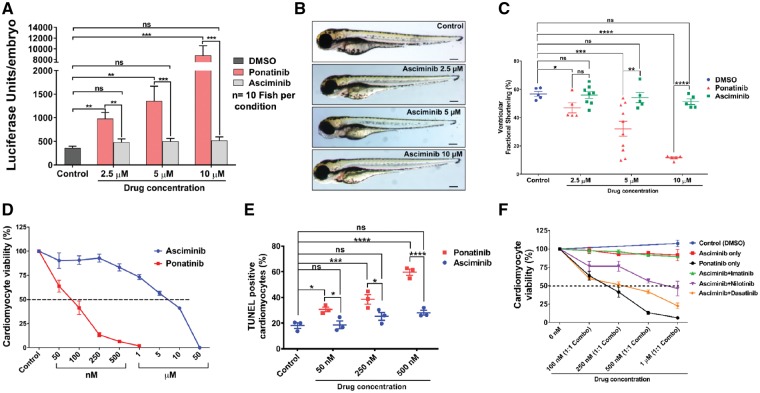Figure 6.
Allosteric inhibitor asciminib (ABL001) as an option for ponatinib. (A) The nppb:F-Luc transgenic zebrafish embryos were treated with asciminib and ponatinib for 72 h and then luciferase assay was performed. Asciminib treatment compared with ponatinib did not induce the BNP reporter. Data are presented as means ± SEM. Statistical analysis was conducted using two-way ANOVA post hoc Tukey test for comparison between groups (P < 0.01, ***P < 0.001); n = 10 fish per condition. ns, not significant. (B) Asciminib when compared with ponatinib was unable to induce the formation of pericardial oedema in zebrafish (AB wildtype). n = 5–10 fish per condition. Scale bar 100 µm. (C) Reduction in fractional shortening post-treatment of asciminib in comparison to ponatinib. Data are presented as means ± SEM. Statistical analysis was conducted using two-way ANOVA post hoc Tukey test for comparison between groups (*P < 0.05, **P < 0.01, ***P < 0.001, ****P < 0.0001). n = 5–10 fish per condition. ns, not significant. (D) Asciminib treatment when compared with ponatinib depicts 50 times higher IC50 value (∼5μM) in cell viability assay. (E) Asciminib does not induce apoptosis in NRVMs when compare with ponatinib by TUNEL assay. Data are presented as means ± SEM. Statistical analysis was conducted using two-way ANOVA post hoc Tukey test for comparison between groups (*P < 0.05, ***P < 0.001, ****P < 0.0001). (F) Cardiomyocyte viability comparison of the combination of TKIs possesses less cardiotoxicity than ponatinib. Cells were treated with equimolar combination (1:1 ratio) of two TKIs upto 72 h followed by cell viability assay.

